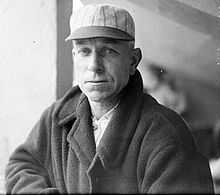| Hugh Duffy |
|---|
 |
|
Outfielder / Manager |
Born: (1866-11-26)November 26, 1866
Cranston, Rhode Island |
Died: October 19, 1954(1954-10-19) (aged 87)
Boston, Massachusetts |
| Batted: Right |
Threw: Right |
|---|
| MLB debut |
|---|
|
June 23, 1888 for the Chicago White Stockings |
| Last MLB appearance |
|---|
|
April 13, 1906 for the Philadelphia Phillies |
| Career statistics |
|---|
| Batting average |
.326 |
|---|
| Home runs |
106 |
|---|
| Runs batted in |
1302 |
|---|
| Teams |
|---|
|
As Player
As Manager
|
| Career highlights and awards |
|---|
|
|
|
|
|---|
| Induction |
1945 |
|---|
| Election Method |
Veteran's Committee |
|---|
Hugh Duffy (November 26, 1866 – October 19, 1954) was an outfielder and manager in Major League Baseball. Best known for setting the MLB single-season record for batting average, he was elected to the Baseball Hall of Fame in 1945.
Career

Duffy in 1921
Duffy, born in Cranston, Rhode Island, was a textile mill worker who had taken up baseball as a semipro for weekend diversion.[1] He played a couple years of minor league ball in the New England League before jumping to the majors, starting up in the league's initial season of 1886, and playing on clubs in Hartford, Springfield and Salem, as well as the Lowell Massachusetts team in 1887.[2]
Duffy entered the National League with Cap Anson's Chicago White Stockings in 1888 after receiving an offer of $2,000 from the club. Anson initially was unimpressed with the 5 ft 7 in (1.70 m), 150 pound Duffy, telling him, "We already have a batboy."[3] He shortly thereafter earned the reputation of an outstanding outfielder and powerful hitter. Duffy ended up replacing Billy Sunday as the team's regular right fielder. He switched leagues, joining the American Association's Boston Reds in 1891; he then returned to the NL with the Boston Beaneaters in 1892, where he enjoyed his best seasons.
Playing in Boston from 1891 through 1900, Duffy knocked in 100 runs or more eight times. In 1894 Duffy had one of the greatest seasons in baseball history, leading the league with 18 home runs, with 145 RBI and a .440 batting average (see Major League Baseball Triple Crown). Duffy's .440 average is the Major League single-season batting average record.[4] He played with two other Hall of Fame outfielders during his career, Tommy McCarthy (as half of the "Heavenly Twins") and Billy Hamilton. Duffy finished his career in 1906 with 106 home runs which was, at the time, one of the highest career totals.
During the 1902 and 1903 seasons, Duffy was player-manager for the Western League's Milwaukee franchise and the following season was hired on as player-manager for the Phillies.[5] Duffy went on to coach the Harvard varsity and freshman baseball squads from 1917 through 1919.[6] He also managed the 1920 Toronto Maple Leafs to a .701 winning percentage — the best in the team's 83-year history, but only good enough for second place in the International League. In 1921, Duffy was hired as full-time manager of the Red Sox, guiding them for two seasons. He had previously been player-manager for the Milwaukee Brewers in 1901, the Phillies from 1904 to 1906 and the White Sox from 1910 to 1911.
He later became a scout for the Boston Red Sox from 1924 to 1953. He played much of his career with fellow Hall of Famers Jimmy Collins and Kid Nichols.
See also
References
- ↑ Bill Ferber (2007) A Game of Baseball: The Orioles, The Beaneaters and The Battle For The 1897 Pennant, University of Nebraska Press, ISBN 978-0-8032-1136-0, pg. 36
- ↑ George V. Tuohey (1897) A History of the Boston Base Ball Club, M.F. Quinn & Co, Excerpt, pg. 130
- ↑ Bill Ferber (2007) A Game of Baseball: The Orioles, The Beaneaters and The Battle For The 1897 Pennant, University of Nebraska Press, ISBN 978-0-8032-1136-0, pg. 37
- ↑ Baseball’s Top 100: The Game’s Greatest Records, p.26, Kerry Banks, 2010, Greystone Books, Vancouver, BC, ISBN 978-1-55365-507-7
- ↑ Louis P. Masur (2003) Autumn Glory: Baseball's First World Series, Hill and Wang, ISBN 0-8090-2763-1, pg. 98
- ↑ "BATTERY MEN AT HARVARD REPORT". The Christian Science Monitor. 02-14-19.
External links
National League batting champions |
|---|
| |
|
National League home run champions |
|---|
| |
|
| Persondata |
|---|
| Name |
Duffy, Hugh |
| Alternative names |
Sir Hugh |
| Short description |
Major League Baseball player and manager |
| Date of birth |
November 26, 1866 |
| Place of birth |
Cranston, Rhode Island |
| Date of death |
October 19, 1954 |
| Place of death |
Boston, Massachusetts |

